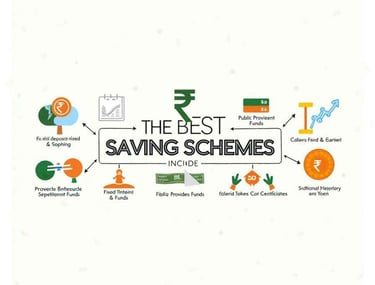Best Saving Schemes in India for 2025
Explore the 10 best saving schemes in India for 2025. Compare features, returns, tax benefits, and choose the right savings option for your financial goals.
FINANCE
Ayushi
8/21/20254 min read


Introduction
Saving money. It sounds simple, right? But ask anyone who’s tried and you’ll hear stories. Some people save like clockwork. Others… they keep thinking “next month.”
In India, saving isn’t just about parking money. It’s about building a safety net, a retirement cushion, a dream fund for your kids.
Luckily, the government and banks keep throwing us options. Plenty of them. From short-term to very long-term. Some schemes are slow and steady, others give a bit more juice.
So, let’s cut through the noise. Here are the best saving schemes in India for 2025 — their features, returns, and the kind of people they actually suit.
1. Public Provident Fund (PPF)
This one’s a classic. Your dad probably has one. Or your uncle keeps bragging about it. The Public Provident Fund is like that boring but reliable friend. Doesn’t fail you.
Put in as little as ₹500 a year. Or max out with ₹1.5 lakh. The interest is ~7.1% (2025). Compounded annually. Which means your money quietly grows behind the scenes.
The only downside? Lock-in of 15 years. That’s a long haul. But you can extend it in 5-year blocks if you’re patient.
The sweet part — tax free. Both the contribution and the interest. Section 80C takes care of that.
Best for:
✔ People who want absolutely safe savings
✔ Tax planners
✔ Long-term retirement builders
2. Sukanya Samriddhi Yojana (SSY)
This one’s emotional. Aimed at the girl child. Parents can open an account before she turns 10. Minimum ₹250 a year. Up to ₹1.5 lakh.
Interest? Around 8%. Which is higher than most schemes right now. And it stays locked until she’s 21, or earlier if she marries after 18.
Think of it as planting a tree the day she’s born. By the time she’s grown, there’s a full shade waiting. Education. Marriage. Stability.
And yes, it’s tax-free. Win-win.
Best for: Parents who want a safe, future-ready plan for their daughter.
3. Senior Citizens Savings Scheme (SCSS)
This one’s all about security after 60. A scheme tailor-made for retirees.
You invest between ₹1,000 and ₹30 lakh. Interest? About 8.2%, paid quarterly. That’s real money coming in every three months. Feels like a salary after retirement.
Lock-in? 5 years. You can stretch it by 3 more years if needed. Plus, Section 80C deductions apply.
Best for: Retired folks who want peace of mind and a steady cash flow.
4. National Savings Certificate (NSC)
Think of this as a safe, middle-path option. Not too short, not too long. You put in ₹1,000 or more (no upper limit). Lock it for 5 years.
Interest is ~7.7%, compounded annually. But you only get it at maturity. So don’t expect monthly returns here.
Yes, tax deductions under 80C.
Best for: Conservative savers who want fixed returns with zero drama.
5. Post Office Monthly Income Scheme (POMIS)
This one’s for people who love monthly income. Retirees especially.
Deposit starts at ₹1,000. Max ₹9 lakh for single accounts, ₹15 lakh for joint ones. Interest rate? Around 7.4%.
Tenure is 5 years. You get a regular monthly payout, which makes it feel like a pension substitute.
Best for: Folks who want stable monthly cash without touching their savings.
6. Kisan Vikas Patra (KVP)
Here’s the promise: your money doubles. Not overnight, but in about 115 months (based on ~7.5% rate).
Minimum deposit ₹1,000. No upper cap. Simple as that.
No tax benefits here. Interest is taxable. But still, people like it because it’s predictable.
Best for: Those who like the sound of “doubling money” in a guaranteed way.
7. Employees’ Provident Fund (EPF)
If you’re salaried, you already know this one. Every month, 12% of your basic + DA is cut and tucked away. Your employer matches it.
The current rate? Around 8.15%. Over years, it builds into a solid retirement pot. And yes, contributions and interest are tax-free (within limits).
You don’t really “choose” EPF. It chooses you if you’re employed in the formal sector.
Best for: Salaried employees planning long-term retirement.
8. Atal Pension Yojana (APY)
Aimed mainly at workers in the unorganized sector. Entry age: 18–40 years.
You contribute a small monthly amount — could be as little as ₹42. Depending on your age and choice, it builds up to a pension between ₹1,000–₹5,000 per month after 60.
The government even adds matching contributions for some. Tax perks under 80CCD.
Best for: People without any pension cover.
9. Bank Fixed Deposits (FDs)
The old faithful. FDs are everywhere. Any bank. Any branch.
Deposit as little as ₹1,000. Tenure can be as short as 7 days or as long as 10 years. Interest rates in 2025 are ~6%–8%.
If you choose a 5-year tax-saving FD, you also get 80C benefits.
Best for: Conservative investors who want absolute safety and guaranteed returns.
10. Recurring Deposits (RDs)
This plan is perfect for people who like small, regular savings. You deposit a fixed amount every month, starting from just ₹100.
Interest rate- About 6%–7.5%.
Tenure- 6 months to 10 years.
On completion of the tenure, you receive a lump sum amount.
Best for: Disciplined savers who want fixed returns without thinking too much.
How to Choose the Right Saving Scheme
Don’t overthink. Start by asking — what’s your goal? Short-term? Long-term?
If you need liquidity, avoid long lock-ins like PPF.
If you want tax benefits, check Section 80C and 80CCD schemes.
If you’re retired, look for steady payouts (SCSS, POMIS).
The key is balance. One scheme won’t do it all. Mix them. Example: PPF for long-term, FD for safety, maybe SSY for your daughter.
Final Thoughts
India’s saving schemes are not about getting rich overnight. They’re about peace of mind. Steady growth. A backup plan when life gets messy.
Start small. ₹500 a year in PPF, ₹100 in an RD — it adds up. What matters is consistency. The earlier you start, the more secure your tomorrow looks.
So don’t just think about saving. Act on it. Your future self will thank you.
About Company


